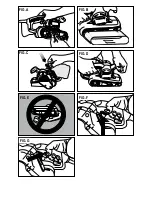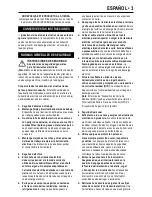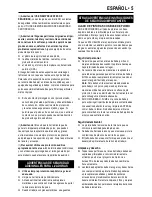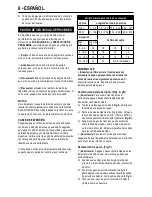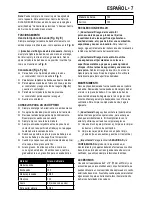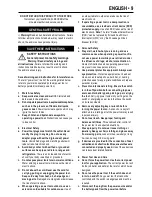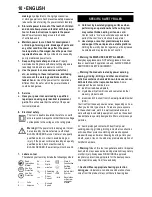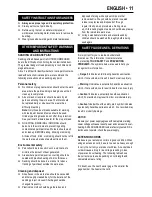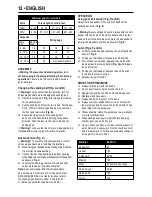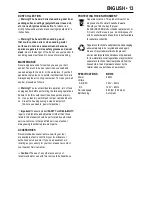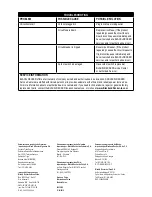
12 • ENGLISH
Minimum gage for cord sets
Volts
Total length of cord in feet
120V
0 - 25
26 - 50
51 - 100
101 - 150
220V
0 - 50
51 - 100
101 - 200 201 - 300
Amperios
Wire gauge
More
than
No more
than
0 - 6 A
18
16
16
14
6 - 10 A
18
16
14
12
10 - 12 A
16
16
14
12
12 - 16 A
14
12
Not recommended
ASSEMBLY
Warning! To prevent accidental operation, turn
off and unplug tool before performing the following
operations. Failure to do this could result in serious
personal injury.
Changing the sanding belt (Fig. A and B)
Warning! To prevent accidental operation, turn off
and unplug sander before changing the sanding belt.
f
Pull the lever shown in Fig. A to release the tension
on the sanding belt.
f
Pull the sanding belt from the two rollers. Put the new
3”x18” (75mm x 457mm) sanding belt in position on
the front and rear rollers (Fig. B).
f
Ensure that the arrows on the sanding belt
and on your belt sander are pointing in the same
direction. Push the lever to the rear to tension the
sanding belt.
Warning! To reduce the risk of injury, make sure belt is
installed with arrows in proper direction of rotation.
Dust collection (Fig. C)
Warning! TTo prevent accidental operation, turn off
and unplug sander before installing the dust bag.
f
When using your belt sander, dust and grit are produced.
It is important to use a dust bag.
f
Connect the dust bag by sliding the plastic opening
of the bag down over the dust exhaust port of the sander
as shown in Fig. C.
f
To empty the dust bag, remove it from the sander
and unzip the bag over a trash container.
Note: A vacuum cleaner attachment is available
as a service part at extra cost. To find your nearest
BLACK+DECKER Service Center location, refer to
the yellow pages directory under “Tools-Electric”
or call the neaest Authorized Service Center.
OPERATION
Using your belt sander (Fig. D and E)
Always hold belt sander firmly with both hands while
sanding as shown in Fig. D.
Warning! Severe abrasion hazard. Always hold the belt
sander with one hand on the switch handle and the other
hand on the front handle. Never operate the belt sander in
an inverted stationary position as shown in Fig. E.
Switch
(Figs. F and G)
f
To start your belt sander, depress the on/off switch as
shown in Fig. F.
f
To stop your belt sander release the on/off switch.
f
For continuous operation, depress the on/off switch
then depress the lock-on button (Fig. G) and release
the on/off switch.
f
To stop your belt sander, depress the on/off switch
to release the lock-on button.
f
Release the on/off switch.
HINTS FOR OPTIMUM USE
f
Always hold the tool with two hands.
f
Do not exert too much pressure on the tool.
f
Regularly check the condition of the sanding sheet.
f
Replace when necessary.
f
Always sand with the grain of the wood.
f
Always start your sander before it is in contact with
the workpiece and do not switch it off until after it has
been lifted from the workpiece.
f
Where possible, clamp the workpiece to a workbench
or similar sturdy surface.
f
When sanding new layers of paint before applying
another layer, use extra fine grit.
f
On very uneven surfaces, or when removing layers of
paint, start with a coarse grit. On other surfaces, start
with a medium grit. In both cases, gradually change to
a fine grit for a smooth finish.
Material
Belt Grit
Solid wood
80
Veneer
150
Chipboard
60/80
Plastics
100
Steel
80 (remove dust bag)
Paint removal
40/60
Balsa wood
100
Acrylic
100


